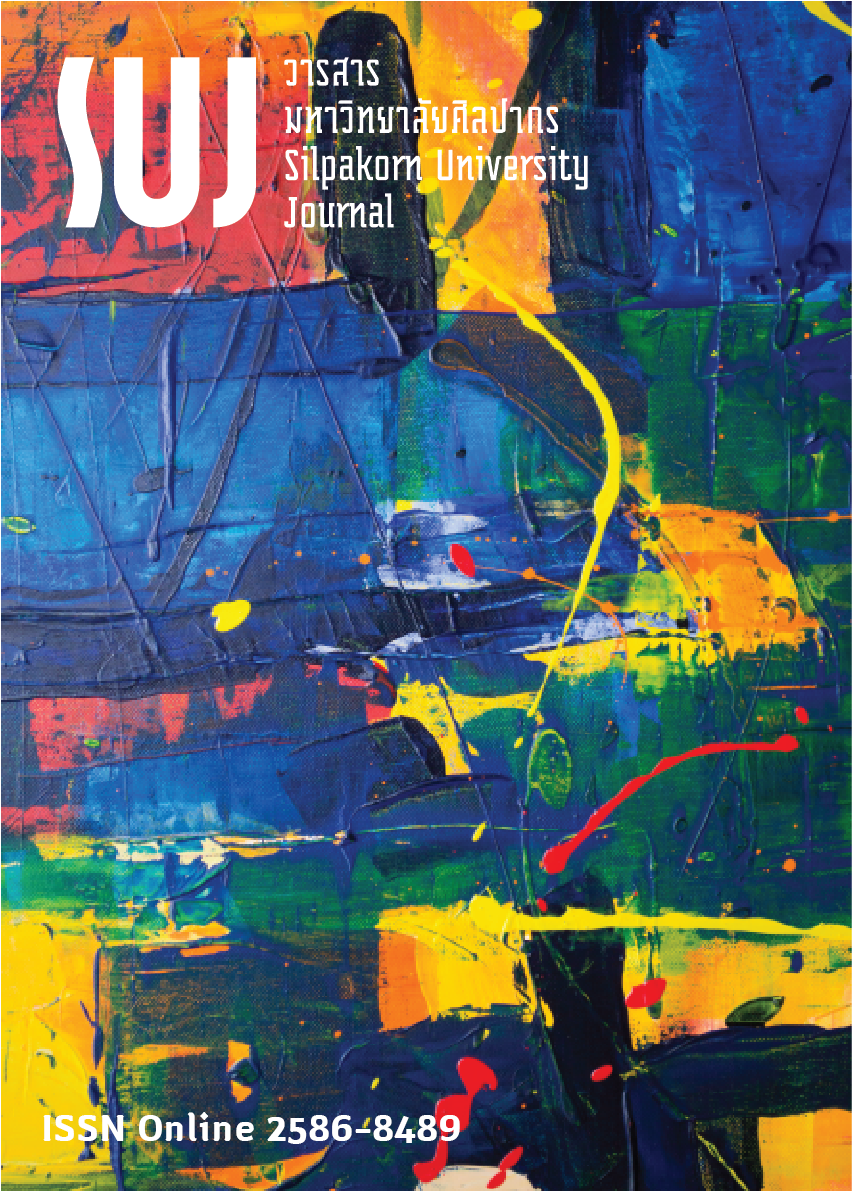ชื่อสถานที่ท่องเที่ยวลำปาง : กลวิธีและข้อผิดพลาดที่พบในการแปลภาษาไทยเป็นภาษาจีน (Lampang tourist attraction names: strategies and errors in translation from Thai to Chinese)
Main Article Content
Abstract
งานวิจัยนี้มุ่งศึกษากลวิธีการแปลชื่อสถานที่ท่องเที่ยวภาษาไทยเป็นภาษาจีนของจังหวัดลำปาง รวมถึงวิเคราะห์ข้อผิดพลาดที่พบในการแปล จากผลการศึกษาพบว่ากลวิธีที่ใช้ในการแปลชื่อสถานที่ท่องเที่ยวมี 7 กลวิธี ได้แก่ การแปลทับศัพท์ การแปลเอาความ การแปลกึ่งทับศัพท์ กึ่งเอาความ การเพิ่มคำ การละคำ การละและเพิ่มคำ และการตั้งชื่อใหม่ ส่วนข้อผิดพลาดที่พบในการแปลแบ่งออกได้เป็น 4 ประเภท คือ ข้อผิดพลาดที่เกิดจากการเลือกใช้คำในภาษาแปล โครงสร้างภาษาในบทแปล การเลือกใช้กลวิธีการแปลที่ไม่เหมาะสมกับต้นฉบับ และการใช้ตัวอักษรจีนผิด ทั้งนี้สาเหตุหลักที่ทำให้เกิดข้อผิดพลาดข้างต้นเกิดจากผู้แปลขาดความเข้าใจด้านวิธีการแปล ขาดความชำนาญในการใช้ภาษาจีนและภาษาไทย ไม่เข้าใจบริบทและวัฒนธรรมของภาษาต้นฉบับและภาษาแปล รวมถึงขาดความละเอียดรอบคอบในการตรวจสอบหาข้อผิดพลาด
This research aims to study the strategies of translating Lampang tourist attraction names into Chinese and analyze errors found in the translation. The results show that 7 strategies were used: whole transliteration, whole translation, half transliteration and half translation, addition, omission, half addition and half omission, and renaming. The errors found in the translation can be divided into 4 categories: the lexical selection in the target language, the word incoherence in Chinese structure, the inappropriate use of translation strategies, and the misusing of Chinese character. The main reasons of all errors can be caused by the lack of the understanding of the principles in translation, Chinese and Thai language proficiency, the understanding of the context and culture in the original and the target language, and the accuracy of evaluating translation quality.
Article Details
References
Baker, M. (1992). In Other Words: A Course Book on Translation. London: Routledge.
Chaichotiranant, Supichaya. (2015). The Study of Erroneous in Translation from Thai to Chinese of Business Chinese Students (การศึกษาข้อผิดพลาดการแปลภาษาไทยเป็นภาษาจีนของนักศึกษาสาขาวิชาภาษาจีนธุรกิจในมิติด้านไวยากรณ์). Panyapiwat Journal, 7(1): 116-126.
Department of National Parks, Wildlife and Plant Conservation. (2019). Botanical Gardens and Arboretum (สวนพฤกษศาสตร์และสวนรุกขชาติ). [Online]. Retrieved March 22, 2019 from http://www.dnp.go.th/botany/Gardens/garden.html
Gao, Y., Leelawatanasuk, Charnchai., Thamcharoenkit, Korsak., Rueangwongsa, Panya. & Mahaphasuthanon, Asama. (2011). A Course in Practical Thai-Chinese Translation (แบบเรียนแปลไทย-จีน). (3rd ed.). Beijing: Beijing Language and Culture University Press.
Inoue, Y. (2007). Cultural Fluency as a Guide to Effective Intercultural Communication: The Case of Japan and the U.S. [Online]. Retrieved March 27, 2019 from http://www.immi.se/intercultural/
Insa-ard, On-anong. (2017). Meaning of City Names in Western China (ความหมายของชื่อเมืองในภาคตะวันตกของจีน). Humanities & Social Sciences, 34(3): 1-19.
Jatupornpimol, Kansinee. (2014). A Translation and Transliteration of Thai Tourist Attraction Names into Chinese (การแปลและการถ่ายถอดเสียงชื่อสถานที่ท่องเที่ยวภาษาไทยเป็นภาษาจีน). Master’s dissertation, Mahidol University, Nakhon Pathom, Thailand.
Kußmaul, P. (2000). Kreatives Übersetzen. Tübingen: Stauffenburg.
Kußmaul, P. (2010). Verstehen und Übersetzen. Ein Lehr- und Arbeitsbuch (aktualisierte Auflage). Tübingen : Naar.
Leelaniramol, Narin. (2013). An Analytic Study of Problems in Translation Chinese Fantasy Fiction into Thai (การศึกษาวิเคราะห์ปัญหาในการแปลวรรณกรรมแฟนตาซีจีนเป็นภาษาไทย). Master’s dissertation, Chulalongkorn University, Bangkok, Thailand.
Ministry of Tourism and Sports. (2018). Wat Pratu Pong (วัดประตูป่อง). [Online]. Retrieved December 5, 2018 from https://thailandtourismdirectory.go.th/th/info/attraction/detail/itemid/3813
Museum Thailand. (2018). Bhum-Lakhon-Museum (หอปูมละกอน). [Online]. Retrieved December 5, 2018 from http://www.museumthailand.com/th/museum/Bhum-Lakhon-Museum
Nida, E. A. (1964). Towards a Science of Translating: with Special Reference to Principles and Procedures Involved in Bible Translating. Leiden: Brill.
Office of the Royal Society. (2019). Museum (มิวเซียม). [Online]. Retrieved March 20, 2019 from http://www.royin.go.th/?knowledges=%E0%B8%A1%E0%B8%B4%E0%B8%A7%E0%B9%80%E0%B8%8B%E0%B8%B5%E0%B8%A2%E0%B8%A1-%E0%B9%99-%E0%B8%81%E0%B8%A3%E0%B8%81%E0%B8%8E%E0%B8%B2%E0%B8%84%E0%B8%A1-%E0%B9%92%E0%B9%95%E0%B9%95%E0%B9%93
Phromyaem, Korawan. (2017). Thammasat University Chinese Studies International Conference, Chinese Place Name in the Map of Bangkok Reign of King Rama VI (ชื่อสถานที่ภาษาจีนในแผนที่กรุงเทพมหานคร รัชสมัยรัชกาลที่ 6). Bangkok: Thammasat University.
Pinmanee, Supannee. (2009). Advanced Translation (การแปลขั้นสูง). Bangkok: Chulalongkorn University Press.
Pinmanee, Supannee. (2012). Translation: from Wrong to Right (แปลผิด แปลถูก: คัมภีร์การแปลยุคใหม่). Bangkok: Chulalongkorn University Press.
Potjanalawan, Pinyapan. (2016). Lampang’s Tale #3 People of Lampang Ethnicity in History (เล่าเรื่องเมืองลำปาง เล่มที่ 3 คนลำปาง ชาติพันธุ์ในชั้นประวัติศาสตร์). Lampang: Lanna Printing.
Potjanalawan, Pinyapan., Munkong, Anticha., & Sethakorn, Wit. (2017). Three accents of Toponym: Using Thai, English and Chinese on Public Signs: A Case Study of Lampang Municipality (“ภูมินาม” สามภาษา: การใช้ภาษาไทย อังกฤษและจีนบนป้ายชื่อสาธารณะเพื่อการท่องเที่ยว กรณีศึกษาเขตเทศบาลนครลำปาง). Local Administration Journal, 10(4): 120-138.
Roungtheera, Theera. (2015). Actes du séminaire national thaïlandais sur la traduction française, Place name and translation: naming a new place in a Thai travel book written in French (ชื่อสถานที่กับการแปล: การตั้งชื่อสถานที่ใหม่ในหนังสือนำเที่ยวประเทศไทยที่เขียนเป็นภาษาฝรั่งเศส). Bangkok: Thammasat University.
Roungtheera, Theera. (2018). The 12th Humanities Research Forum in Thailand, Thainess and the Otherness in Thai dish Names Translated into French (ความเป็นไทยและความเป็นอื่นในชื่ออาหารไทยที่แปลเป็นภาษาฝรั่งเศส). Nakhon Pathom: Silpakorn University.
Sikkhakosol, Thavorn. (2017). Chinese Characters Language Epigram and Proverb (ภาษา อักษร และคำคมสุภาษิตจีน). Bangkok: Saeangdao Publishing House.
Sodsonghrit, Mech. (2012). A survey and analysis of the tradename in Chinese Thais merchant shop and stores in Muang District, Ubon Ratchathani Province (การสำรวจและศึกษาวิเคราะห์ชื่อร้านค้าภาษาจีนของชาวไทยเชื้อสายจีนในเขตอำเภอเมือง จังหวัดอุบลราชธานี). Journal of Liberal Arts, Ubon Ratchathani University, 8(2): 59-89.
Srichomthong, Phattanit. (2016). Linguistic landscape in Lanna (ภูมิทัศน์ภาษาในล้านนา). Chiangmai: Wit Design.
Teochew Sound Dictionary. (2018). Yuè (越). [Online]. Retrieved March 20, 2019 from http://www.czyzd.com/search?keyword=%E8%B6%8A
Thai Elephant Conservation Center. (2018). Thung Kwian Forest Park (สวนป่าทุ่งเกวียน). [Online]. Retrieved December 5, 2018 from http://www.thailandelephant.org/th/thungkwian.php
Thamcharoenkit, Korsak. (2010). Principal of Thai-Chinese Translation (หลักการแปลไทย-จีน). Bangkok: Siam Chinese Publishing.
The Royal Institute. (2011). Dictionary of The Royal Institute Year 2011 (พจนานุกรม ฉบับราชบัณฑิตยสถาน พ.ศ. 2554). Bangkok: The Royal Institute.
Vessakosol, Pimpan. (2003). A Survey of Translators’ Attribute (การศึกษาสำรวจคุณสมบัติของนักแปล). Journal of Liberal Arts, 3(1): 79-94.
Widenfelt, V. BM., Treffers, D. A. P., Beur, D. E., Siebalink, M. B. & Koudijs, E. (2005). Translation and Cross-Cultural Adaptation of Assessment Instruments Used in Psychological Research With Children and Families. Children Child and Family Psychology Review, 8(2): 135-147.

